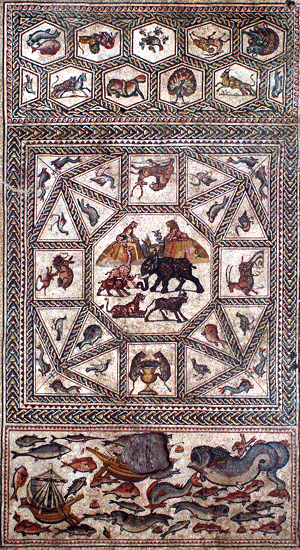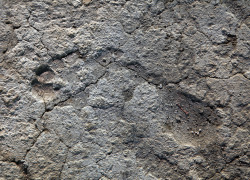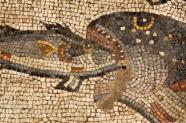
Scroll down the list for other articles.

1,700-Year-Old Mosaic Floor to be unveiled in Lod, Israelby Hana Levi Julian 2 July 2009
Amazingly well-preserved, the mosaic spans 180 square meters and is composed of colored carpets that depict in startling detail the mammals, birds, fish and a variety of flora, as well as sailing and merchant ships from the period. It is not known what kind of building the mosaic floor graced. The discovery was made during an excavation led by archaeologist Miriam Avissar prior to the widening of a road – Rehov HeHalutz – by the Lod municipality. It caused a wave of excitement in Israel, prompting an influx of 30,000 tourists who came to view the beautiful mosaic when it was first opened to the public. The mosaic was soon covered up again in order to protect it until funding was secured to pay for proper restoration and permanent exhibition of the archaeological treasure. The Leon Levy Foundation and Shelby White, chairman of the Friends of the of the Israel Antiquities Authority, have since donated the funds to enable the IAA to excavate, conserve and establish the Lod Mosaic Archaeological Center on the site. The conservation and development work are scheduled to take approximately
two years. During that period, and because of the rarity and exceptional
quality of the find, a section of the mosaic will be sent on exhibit to
the prestigious Metropolitan Museum of Art in New York. During this time
the planning and implementation work will carried out at the site in Lod,
at the end of which the mosaic will be returned to its permanent home
and the site will be opened to the public. How to reach the site: The mosaic is located in the eastern part of Lod, next to the entrance to the city from Ginnaton Junction. This junction is easily reached from Ben-Gurion International Airport and from the country’s two main highways: Highway 1, which links Tel Aviv with Jerusalem, and Highway 6, which connects the north of the country with the south. The site is located between two streets: He-Halutz Street which leads to the market place and Struma Street, which leads to the city’s historic center.
AP Photo/Sebastian Scheiner
|
All
content is copyright of © Mosaic Matters and its contributors.
All rights reserved
Mosaic
Matters is:
Editor: Paul Bentley
Web Manager/Designer: Andy Mitchell
 (IsraelNN.com)
An ancient mosaic floor featuring the flora and fauna enjoyed by the artisans
nearly two millennia ago is about to be unveiled in the city of Lod. The
site of the mosaic will be open to the general public from July 9 through
July 11 – but one can also observe the conservation work being performed
on the mosaic in a live broadcast via the Israel Antiquities Authority
(IAA) web site at www.antiquities.org.il . The 1,700-year-old floor, one
of the most magnificent and largest mosaics ever revealed in the State
of Israel, was first uncovered in the city in 1996.
(IsraelNN.com)
An ancient mosaic floor featuring the flora and fauna enjoyed by the artisans
nearly two millennia ago is about to be unveiled in the city of Lod. The
site of the mosaic will be open to the general public from July 9 through
July 11 – but one can also observe the conservation work being performed
on the mosaic in a live broadcast via the Israel Antiquities Authority
(IAA) web site at www.antiquities.org.il . The 1,700-year-old floor, one
of the most magnificent and largest mosaics ever revealed in the State
of Israel, was first uncovered in the city in 1996. While
working on detaching the mosaic from the ground, Antiquities Authority
workers discovered footprints and sandal prints on the plaster bedding
below. Experts believe the prints belong to the builders of the mosaic,
and further speculate that they had used their feet to pack the plaster.
Sandal prints in sizes 34, 37, 42 and 44 were discovered. (Source:
Haaretz.com)
While
working on detaching the mosaic from the ground, Antiquities Authority
workers discovered footprints and sandal prints on the plaster bedding
below. Experts believe the prints belong to the builders of the mosaic,
and further speculate that they had used their feet to pack the plaster.
Sandal prints in sizes 34, 37, 42 and 44 were discovered. (Source:
Haaretz.com)